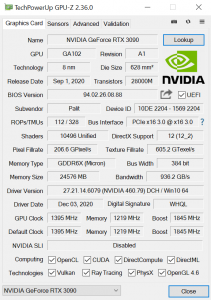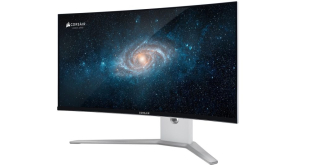
While the latest rumours suggest the RTX 3080 Ti has been delayed ‘indefinitely', RTX 3090 remains the go-to option for those demanding the fastest consumer GPU currently on the market. The fact RTX 3090s are so expensive also means there is actually some stock – if you are prepared to shell out £1889 for the Palit RTX 3090 GameRock OC we are looking at today.
On paper, there's a lot to like about Palit's RTX 3090 GameRock OC. For starters, it has dual-BIOS functionality baked in, offering users a performance mode and a silent mode. The latter raises the power target to 420W (!), which is a 70W increase over stock, while also pushing the rated boost clock up to 1845MHz, another sizeable boost compared to the RTX 3090's stock specifications.
And then there's the RGB. There's no trying to hide it with this card, the GameRock OC is the most blinged-out graphics card, in terms of RGB lighting, that I have ever seen. If you don't like RGB, then be warned – this is not the card for you. If you are an RGB lover though, there's no denying that the GameRock OC is pretty special in that regard.
| GPU | RTX 3090 | RTX 3080 | RTX 2080 Ti (FE) | RTX 2080 SUPER | RTX 2080 (FE) |
| SMs | 82 | 68 | 68 | 48 | 46 |
| CUDA Cores | 10496 | 8704 | 4352 | 3072 | 2944 |
| Tensor Cores | 328 | 272 | 544 | 384 | 368 |
| RT Cores | 82 | 68 | 68 | 48 | 46 |
| Texture Units | 328 | 272 | 272 | 192 | 184 |
| ROPs | 112 | 96 | 88 | 64 | 64 |
| GPU Boost Clock | 1695 MHz | 1710 MHz | 1635 MHz | 1815 MHz | 1800 MHz |
| Memory Data Rate | 19.5 Gbps | 19 Gbps | 14 Gbps | 15.5 Gbps | 14 Gbps |
| Total Video Memory | 24GB GDDR6X | 10GB GDDR6X | 11GB GDDR6 | 8GB GDDR6 | 8GB GDDR6 |
| Memory Interface | 384-bit | 320-bit | 352-bit | 256-bit | 256-bit |
| Memory Bandwidth | 936 GB/Sec | 760 GB/Sec | 616 GB/sec | 496.1 GB/sec | 448 GB/sec |
| TGP | 350W | 320W | 260W | 250W | 225W |
RTX 3090 uses the GA102 GPU, which also forms the basis for RTX 3080. Even with its 82 SMs, however, this is not actually a full implementation of GA102, as a fully populated die houses 84 SMs, so just two are missing from the RTX 3090. Ampere has doubled the number of FP32 shaders per SM, so there’s a total of 128 CUDA Cores in each of those 82 SMs, for a grand total of 10496.
Each SM also houses a single RT Core, as well as four Tensor cores, giving us 328 with the RTX 3090. Additionally, there’s 328 texture units and 112 ROPs.
As for the memory, this is a significant step up from the RTX 3080. RTX 3090 of course still uses GDDR6X memory, but it has over double the amount with 24GB. Additionally, the modules are clocked slightly faster at 19.5Gbps, and the memory interface is also slightly wider than RTX 3080, with a 384-bit interface. Total memory bandwidth comes in just shy of 1TB/s, hitting 936 GB/s.
Finally, we can see Palit has pushed the clock speed slightly further than reference. RTX 3090 defaults to a boost clock of 1695MHz, but Palit has added an extra 150MHz to this figure, bringing it up to 1845MHz. Later in the review we test exactly how fast the GPU actually operates, as we would expect GPU Boost to bring clock speed well above the rated speed.
 KitGuru KitGuru.net – Tech News | Hardware News | Hardware Reviews | IOS | Mobile | Gaming | Graphics Cards
KitGuru KitGuru.net – Tech News | Hardware News | Hardware Reviews | IOS | Mobile | Gaming | Graphics Cards




